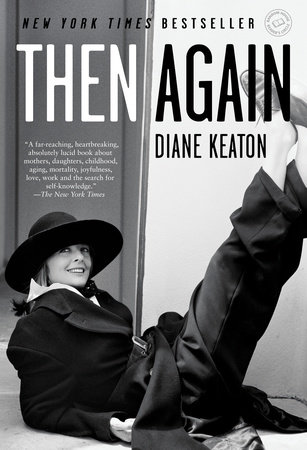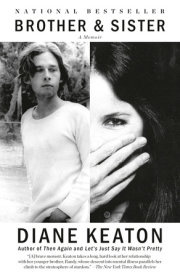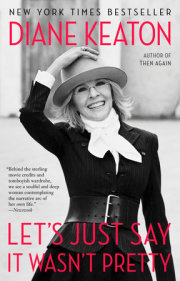THINKMom loved adages, quotes, slogans. There were always little reminders pasted on the kitchen wall. For example, the word think. I found think thumbtacked on a bulletin board in her darkroom. I saw it Scotch-taped on a pencil box she’d col- laged. I even found a pamphlet titled think on her bedside table. Mom liked to think. In a notebook she wrote,
I’m reading Tom Robbins’s book Even Cowgirls Get the Blues.
The passage about marriage ties in with women’s struggle for accomplishment. I’m writing this down for future THINKING . . . She followed with a Robbins quote: “
For most poor dumb brainwashed women marriage is the climactic experience. For men, marriage is a matter of efficient logistics: the male gets his food, bed, laundry, TV . . . off- spring and creature comforts all under one roof. . . . But for a woman, marriage is surrender. Marriage is when a girl gives up the fight . . . and from then on leaves the truly interesting and significant action to her husband, who has bar- gained to ‘take care’ of her. . . . Women live longer than men because they really haven’t been living.” Mom liked to think about life, especially the experience of being a woman. She liked to write about it too.
In the mid-seventies on a visit home, I was printing some photographs I’d taken of Atlantic City in Mother’s darkroom when I found something I’d never seen. It was some kind of, I don’t know, sketchbook. On the cover was a collage she’d made out of family photographs with the words
It’s the Journey That Counts, Not the Arrival. I picked it up and flipped through the pages. Although it included several collages made from snapshots and magazine cutouts, it was filled with page after page of writing.
Had a productive day at Hunter’s Bookstore. We re- arranged the art section and discovered many interesting books hidden away. It’s been two weeks since I was hired. I make 3 dollars and thirty-five cents an hour. Today I got paid 89 dollars in total.This wasn’t one of Mom’s typical scrapbooks, with the usual napkins from Clifton’s Cafeteria, old black-and-white photographs, and my less-than-thrilling report cards. This was a journal.
An entry dated August 2, 1976, read:
WATCH OUT ON THIS PAGE. For you, the possible reader in the future, this takes courage. I’m speaking of what is on my mind. I am angry. Target—Jack—bad names, those he has flung at me—NOT forgotten and that is undoubtedly the problem—“You frigin’ bastard”––all said—all felt. God, who the hell does he think he is?That was it for me. This was raw, too raw. I didn’t want to know about an aspect of Mother and Father’s life that could shatter my perception of their love. I put it down, walked out of the darkroom, and did not open another one of her eighty-five journals until she died some thirty years later. But, of course, no matter how hard I tried to deny their presence, I couldn’t help but see them resting on bookshelves, or placed underneath the telephone, or even staring up at me from inside a kitchen drawer. One time I began looking through Mom’s new Georgia O’Keeffe
One Hundred Flowers picture book on the coffee table, only to find a journal titled W
ho Says You Haven’t Got a Chance? lying underneath. It was as if they were conspiring, “Pick us up, Diane. Pick us up.” Forget it. There was no way I was going to go through that experience again. But I was impressed with Mom’s tenacity. How could she keep writing without an audience, not even her own family? She just did.
She wrote about going back to school at age forty. She wrote about being a teacher. She wrote about every stray cat she rescued. When her sister Marti got skin cancer and lost most of her nose, she wrote about that too. She wrote about her frustrations with aging. When Dad got sick in 1990, her journal raged at the injustice of the cancer that attacked his brain. The documentation of his passing proved to be some of Mom’s finest reporting. It was as if taking care of Jack made her love him in a way that helped her become the person she always wished she could have been.
I was trying to get Jack to eat today. But he couldn’t. After a while, I took off my glasses. I put my head close to his, and I told him, I whispered to him, that I missed him. I started to cry. I didn’t want him to see, so I turned my head away. And Jack, with what little strength remained in that damn body of his, took a napkin from my pocket and slowly, as with everything he did, slowly, so slowly, he looked at me with those piercing blue eyes and wiped the tears away from my face. “We’ll make it through this, Doro- thy.”He didn’t. In the end, Mom took care of Dad, just as she had taken care of Randy, Robin, Dorrie, and me—all our lives. But who was there for her when she wrote in a shaky hand: June 1993.
This is the day I heard I have the beginning of Alzheimer’s disease. Scary. Thus began a fifteen-year battle against the loss of memory.
She kept writing. When she could no longer write paragraphs, she wrote sentences like
Would we hurt each other less if we touched each other more? and
Honor thyself. And short questions and statements like
Quick. What’s today’s date? Or odd things like
My head is taking a turn. When she couldn’t write sentences, she wrote words:
RENT. CALL. FLOWERS. CAR. And even her favorite word,
THINK. When she ran out of words, she wrote numbers, until she couldn’t write anymore.
Dorothy Deanne Keaton was born in Winfield, Kansas, in 1921. Her parents, Beulah and Roy, drifted into California before she was three. They were heartlanders in search of the big dream. It dumped them into the hills of Pasadena. Mom played the piano and sang in a trio called Two Dots and a Dash at her high school. She was sixteen when her father drove off, leaving Beulah and her three daughters to fend for themselves. It was hard times for the Keaton girls in the late thirties. Beulah, who’d never worked a day in her life, had to find a job. Dorothy gave up her college dreams in order to help around the house until Beulah finally found work as a janitor.
I have a photograph of sixteen-year-old Dorothy standing next to her father, Roy Keaton. Why did he leave his favorite daughter, his look-alike; why? How could he have driven away knowing he would forever break some part of her heart?
Everything changed when Dorothy met Jack Hall on a basketball court at Los Angeles Pacific College in Highland Park. Mom loved to recall how this handsome black-haired, blue-eyed young man had come to meet her sister Martha but only had eyes for her. She would laugh and say, “It was love at first sight.” And it must have been, because not long after that, they eloped in Las Vegas at the Stardust Hotel.
Mother never told me of her dreams for herself. There were hints though. She was president of the PTA as well as the Arroyo Vista Ladies Club. She was a Sunday-school teacher at our Free Methodist church. She entered every con- test on the back of every cereal box. She loved game shows. Our favorite was Queen for a Day, emceed by Jack Bailey, who began each episode, five days a week, with “Would YOU like to be . . . QUEEN . . . FOR . . . A . . . DAY?” The game went like this: Bailey interviewed four women; whoever was in the worst shape—assessed by the audience applause meter—was crowned Queen for a Day. With “Pomp and Circumstance” playing, he would wrap the winner in a velvet cape with a white fur collar, place a sparkling tiara on her head, and give her four dozen red coronation roses fromCarl’s of Hollywood. Mom and Auntie Martha wrote their sad stories on the application sheet more than once. She almost made the cut when she wrote, “My husband needs a lung.” When pressed for details, Mom told the truth—well, sort of. Jack Hall, an ardent skin diver, needed to dive deeper in order to put more food on his family’s plates. Mom was eliminated.
One morning I woke up to a group of strangers walking around our house examining every room. Mom hadn’t bothered to tell us she had entered the Mrs. America contest at our local level. Mrs. America was a pageant devoted to finding the ideal homemaker. Later she informed us kids it was a competition of skills that included table-setting, floral-arranging, bed-making, and cooking, as well as managing the family budget and excelling in personal grooming. All we could think was WOW.
Copyright © 2011 by Diane Keaton. All rights reserved. No part of this excerpt may be reproduced or reprinted without permission in writing from the publisher.








